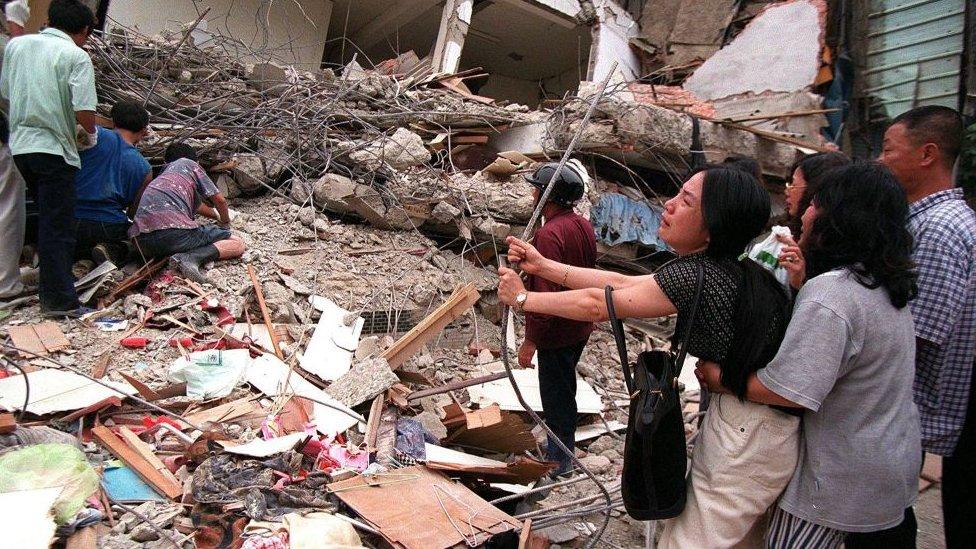Taiwan earthquake: How the island's two-decade preparation saved it
- Published
The impact of the 7.4 magnitude earthquake in Taiwan
When disasters happen, particularly when big earthquakes strike, the world's media is drawn like flies to the most dramatic destruction. It is understandable. But it often portrays a distorted picture of what has happened.
You can see it here in the city of Hualien. Camera teams are crowded around a 10-storey building leaning over at a terrifying angle. It all looks bizarre and scary. But that was only one of a handful of buildings which suffered structurally, in a city of tens of thousands.
A hundred metres away beyond the police cordon, the streets of Hualien look entirely normal. Shops and cafés are open, traffic is flowing. Drive through the city and if you didn't know a big quake had struck days ago, you wouldn't guess it.
The fact that this city has survived largely unscathed has sparked immediate discussion of how and why.
Just over a year ago, we saw earthquakes of about the same magnitudes striking Turkey and Syria, causing the deaths of more than 50,000 people. These countries, of course, had far fewer resources. But when a much smaller 6.7 magnitude quake hit the city of Christchurch in New Zealand in 2011, almost the entire city centre was flattened.
Taiwan is also often on the fault lines, but it has made significant progress in coping with shakes. Many say the wake-up call was Taiwan's 1999 Chi Chi earthquake - the worst in its history. It caused the deaths of more than 2,400 people and destroyed tens of thousands of buildings.
I witnessed the aftermath of that disaster. In the central county of Nantou many apartment buildings had been toppled. What was most striking was how many of them were brand new.
I remember a huge 20-storey building that had snapped off at its foundations and was lying flat on its side - still almost completely intact.
The catastrophic damage prompted a lot of anger and soul-searching about why so many brand new buildings had failed. Experts said their design was fundamentally flawed. The base pillars were not big enough, the amount of steel in them too small.
Their findings won't have been entirely a surprise: when I lived in Taipei in the 1990s, there were repeated construction scandals.

The loss of life in the 1999 earthquake triggered a public outcry and demands for stronger action
A building I lived in as a student was condemned after it was found to have been built with concrete made with sea sand. Sea sand is much cheaper than river sand, but has a much higher saline content. That corrodes the steel reinforcement bars, causing concrete cancer.
We were told even a medium-level quake could have brought the building down. Another investigation by the Taipei city mayor found old oil cans had been placed inside the concrete pillars of a new building.
The construction company was accused of using this trick to skimp on concrete and increase its profit.
A lot has changed since then. Following the Chi Chi quake, building codes were changed.
All new buildings are now required to meet a basic earthquake resistance level that means they can withstand a certain level of shaking without major structural failures.
BBC Asia Correspondent Rupert Wingfield-Hayes reports on the hundreds of landslides unleashed by the quake
The government is also constantly revising the quake resistance levels required of buildings - identifying those that need upgrading. After 1999, they carried out a sweep of seismic retrofitting - that typically involved adding a framework of steel beams to a building's exterior, or adding reinforcements like extra pillars. That applied to infrastructure like bridges too.
Prof Yih-Min Wu at the National Taiwan University, who has worked in the country's response and prevention departments for decades, says: "Taiwan is hit so frequently by dangerous earthquakes [that] most of the poor quality buildings are already gone."
And corrupt construction practices are prosecuted. Following the Tainan earthquake in the island's south-west in 2016, when a 17-storey high-rise collapsed killing dozens, five people involved in the building's construction were prosecuted and jailed.
Of the 10 deaths reported so far this week, only one tragic loss of life occurred due to a collapse of a building - that 10-storey building in Hualien I mentioned earlier. The others were associated with landslides and rockfalls.
And that points to another main reason for why Taiwan this time saw limited damage.
Luck played a part. Wednesday's quake began offshore before hitting south of the nearest major population centre, Hualien.
Seismology maps show how the epicentre was 30km (18 miles) to the south of the city, so Hualien and its environs were spared the worst shaking.
This instead happened in the mountains to the south, west and north, where it unleashed huge rock slides, damaging roads and bridges, and tragically, causing deaths.
Wednesday's event contrasts with Nantou in 1999, and Turkey and Syria last year, where earthquakes struck very close to densely populated areas.
Still, the 7.4 earthquake was an incredibly powerful event, shaking not only the island but lands beyond that too.
Fortunately for Taiwan, this time it was well-prepared.
Other pillars of Taiwan's earthquake response:
Early warning system: Sensors placed all around the island are able to pick up the first vibrations of an earthquake and provide mobile and TV alerts to the public near an epicentre with 2-8 seconds lead time. But the system still suffers glitches - Taipei residents did not get some phone alerts.
Public awareness: Taiwanese are used to quakes and know what to do, after school and workplace drills were mandated after 1999.
Fast responders: The island's disaster response team actively tracks social media and can tap into surveillance cameras to assess damage - triangulating which locations to send aid to.
With additional reporting by Frances Mao in Singapore